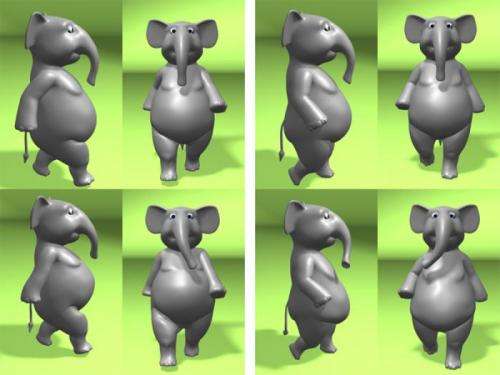Lifelike wobble thanks to new software

The cartoon characters so loved by young and old audiences alike are becoming increasingly lifelike. In order for them to look realistic, animators invest a lot of time in making a fat belly wobble as naturally as possible while walking, for instance. A project by ETH Zurich and Disney Research should make life easier for the filmmakers in future.
ETH Zurich doctoral student Fabian Hahn shows how Professor Peanuts, a cartoon elephant, totters across the screen. The animal looks stiff and not particularly lifelike. "In real life, the trunk and ears would also sway and the fat belly wobble along," stresses Hahn.
If animators move a virtual character, they have to mind which body parts would move along indirectly in real life by observing reality closely and transferring it to the virtual realm. Such indirect movements include for instance the wobble of a belly or the bulging of a muscle during an arm movement.
Until now, filmmakers have had the choice of either painstakingly creating these additional movements by hand or relinquishing the control: There are already computer programmes that add such effects to an existing animation. However, the automation makes subsequent changes tricky. In the course of his doctoral thesis under Markus Gross, professor of visual computing, Hahn teamed up with Bob Sumner of Disney Research to develop a new software programme that makes life easier for the artists by proposing additional movements, which the artists can easily adapt afterwards.
Movement with levers
Existing programmes that automatically add effects like the wobbling of a stomach do not use the typical animator's toolbox, the so-called rig space – the sum of the levers the artists use to move for instance the character's whole stomach, which consists of many individual dots. Instead, these programmes calculate the movement for every individual point instead of the levers, which makes subsequent improvements difficult. In order to adjust the animation, the artist has to painstakingly shift every single dot – for twenty-four frames per second of film!
Unlike previous software, however, Hahn's programme uses the levers in the rig space to mimic physical effects and make the wobbling look as realistic as possible (video). As the programme uses the levers, the artists can easily make changes at a later stage using the rig space levers as usual to move entire body parts instead of shifting individual dots.
Faster thanks to anticipation
Last year, Hahn published a prototype of the programme that still took a long time to test the movement of all levers until a physical effect was simulated optimally. Now he is showcasing a new version of programme at the SCA, one of the most important conferences in the world for computer animation.
The new programme calculates how it has to move the levers correctly much more quickly. To achieve this, Hahn incorporated the option of anticipating the movements for the next images in the animation sequences into the software. Consequently, the programme no longer tests all the degrees of freedom of all levers for each of the twenty-four frames per second. Instead, it assumes that the movements calculated for one frame – ascertained by automatically trying out all levers in all degrees of freedom – are also suitable for the next couple of frames. At the same time, it calculates how far the estimation strays from reality. If the anticipation deviates too much, the programme tests all the degrees of freedom of the levers again.
No inadvertent loss of mass
Using this technique, the programme conjures up images on the screen much more quickly that are as close to reality as ever before. Thus Professor Peanuts wobbles and totters across the screen, a movement the programme now only needs minutes, not hours, to calculate. Another advantage is that the software also prevents volume from being lost on the animated characters, as Hahn explains, pointing to the ring of fat belonging to a sumo wrestler that grows noticeably flatter in the "hand-animated" movement (video). His programme, on the other hand, ensures that it bulges while moving and the mass remains intact.
Although there are no official plans to use the software as yet, Hahn hopes that his programme developed in collaboration with Disney Research will be used in animated films in the near future. Perhaps a pot-bellied Professor Peanuts will be wobbling across the big screen in the next few years – with an air of ETH Zurich.
More information: F. Hahn, S. Martin, B. Thomaszewski, R. Sumner, S. Coros, M. Gross. Rig-Space Physics; Proceedings of ACM SIGGRAPH (Los Angeles, USA, August 5-9, 2012), ACM Transactions on Graphics, vol. 31, no. 4, pp. 72:1-72:8
F. Hahn, B. Thomaszewski, S. Coros, S. Martin, R. Sumner, M. Gross. Efficient simulation of secondary motion in rig-space; Proceedings of the 2013 ACM SIGGRAPH/Eurographics Symposium on Computer Animation (Anaheim, USA, July 19-21, 2013)
Provided by ETH Zurich











.jpg)







